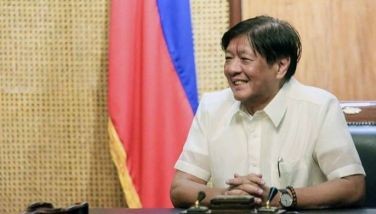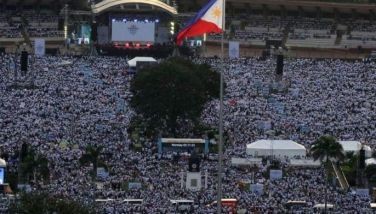Bad banker

The government is the Philippines’ biggest banker. It is also the country’s largest corporation. As a financier of economic activity, the government is the country’s worst banker – in terms of failure to bring about post-1986 industrial modernization, robust agricultural production and a more dynamic economy. To put it bluntly, government banks are literally sitting on their as**s.
This colossal failure may explain why the Philippines has among the world’s worst agricultural production growth rates – a pitiful 0.2 percent per year, in the last 30 years.
In theory, agricultural or food production should grow higher than the current population growth rate of 1.8 percent per year. That means a minimum two percent per year. In the past ten years, agriculture’s share of total economic production or GDP has shrunk, from over 14 percent in 2011 to less than 10 percent today. During the same period, 16 million more Filipinos were born. With a quarter of its food needs imported, the Philippines suffers from massive malnutrition and hunger.
The government banking failure may also explain why the country’s nearly a million small and medium enterprises (99.99 percent of corporations in the Philippines) never grew beyond being mom-and-pop stores and boutique handicraft makers – short of cash, defective in management and unreliable in supplying wholesale orders, especially exports.
The Republic of the Philippines is the proud owner of Land Bank of the Philippines (LB), Development Bank of the Philippines (DBP), United Coconut Planters Bank (UCPB, owned 97 percent by LB) and Al-Amanah Islamic Investment Bank of the Philippines. Through the state-owned private pension fund SSS, the government also owns 14 percent of Union Bank, today, among the country’s most dynamic, profitable and digital-ready banks. The 14 percent is equivalent to P132.86 billion of UB’s P949.6-billion assets.
Since the state-owned banks are not listed in the stock exchange, they are also the least transparent among the major banks. They don’t conduct periodic briefings for analysts to narrate how great (or bad) they have been in the three immediately preceding months. Hence, you can perceive an air of smugness about them.
LB is the Philippines’ second largest commercial bank, with assets (as of Sept. 30, 2022) of P2.761 trillion – just P925 billion shy of the resources of No. 1, the Henry Sy family-owned BDO Unibank’s P3.726 trillion.
DBP is the country’s eighth largest bank, with assets of P1.035 trillion. If you combine the assets of LB (P2.761 trillion) and DBP (P1.035 trillion), you get a P3.796-trillion behemoth, one P69.2 billion bigger than BDO. Add the P132.8 billion of government in UB and you have P3.928 trillion of state assets in the banking business.
The government owns nearly a fifth (19 percent) of local banking’s P20.6 trillion resources. Those assets are not being efficiently nor effectively deployed. The government’s share of economic production has been diminishing. Despite being awash with cash, government banking is a yoke on the common man.
Carlos “Sonny” Dominguez, president Duterte’s chief economic manager, had the brilliant idea of merging Land Bank and DBP, with LB as the surviving entity. It was to promote efficiency, minimize waste and duplication, cut costs and achieve unrivalled synergy. Finance Secretary Ben Diokno has the same idea – merge LB and DBP.
As a business writer, I covered both LB and DBP for many decades, from 1970. DBP, without doubt, has been the better bank. DBP financed the country’s post-war recovery and modernization, the major industrial projects and exports of the 1960s and 1970s and many of the emerging growth enterprises.
Until 1969, Philippine exports, in dollars, were ten times those of South Korea, Taiwan, Hong Kong and Singapore. Today, it’s the reverse.
Land Bank, in particular, is guilty of mission failure. It was supposed to emancipate the country’s rice and corn farmers (six million in all) from centuries of bondage by bankrolling their land assets given under agrarian reform. Instead, our farmers, along with our fishermen, are the poorest of the poor Filipinos.
Even today, LB has P2.456 trillion of deposits. Yet, it lent out only P992 billion – just 40 percent of the loanable money it does not even own. The ratio for No. 1 BDO – 80 percent. BDO lends P80 for every P100 of deposits. In other words, Land Bank should be deploying easily P1 trillion in loans to help farmers, help SMEs, help businesses, but it does not. As a rule, every peso of deposit should generate P7 in economic activity.
Despite having 75 percent of the size of BDO, Land Bank’s profits are not even 75 percent of BDO’s. In 2022, BDO made P57 billion net, or P4.75 billion per month. In 2022, LB made P30.1 billion net, or P2.5 billion profits monthly. This P2.5 billion is just 52 percent (half) of BDO’s P4.75 billion monthly profit haul. LB should be 50 percent more profitable – if it is as good as BDO, its peer.
Why the mission failure and less than ideal profits? Smugness. Laziness. Lack of dynamism.
Do you know the impact of P1-trillion deposits lying idle in Land Bank coffers?
If every P2 million can create a job (it does, ask the jeepney drivers), then P1 trillion (that’s P1,000 billion) can create 500,000 jobs – half of the jobs the economy creates in a bad year. And that should have been 500,000 families rescued from malnutrition, hunger, abject poverty. It would have made the NPA irrelevant overnight.
Should Land Bank and DBP merge then? No.
It’s like marrying a person sick with long COVID and a fully vaccinated, never-been-sick other person and they go to bed every night.
* * *
Email: [email protected]
- Latest
- Trending




























